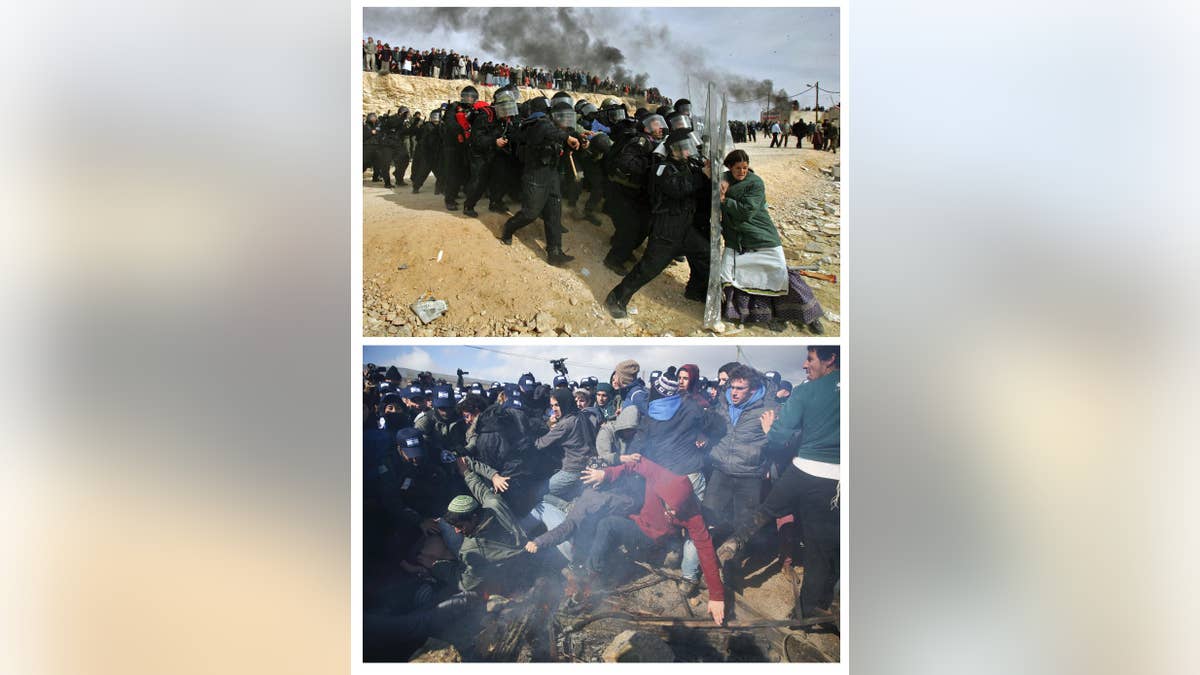
This combination of photos by Oded Balilty shows his Pulitzer Prize winning photograph of Israeli settlers challenging security forces at the West Bank outpost of Amona on Feb. 1, 2006, top, and at bottom Israeli settlers battling eviction from the same outpost exactly eleven years later, on Wednesday, Feb. 1, 2017. (AP Photo/Oded Balilty) (The Associated Press)
AMONA, West Bank – Exactly 11 years ago, thousands of Israeli security forces clashed with settlers and their supporters as they tried to demolish nine homes in the Amona outpost in the West Bank. On that day, AP photographer Oded Balilty took a picture of a defiant protester attempting to block Israeli troops that would win him a Pulitzer Prize.
On Wednesday, Balilty returned to Amona to document the court-ordered evacuation of the remainder of the illegal outpost, finding a chaotic but less violent scene on the wind-swept hilltop.
Balilty said the tensions surrounding each event were different, making for two very distinct outcomes. In 2006, the demolition took place on the heels of Israel's 2005 withdrawal from the Gaza Strip, in which Israel withdrew all 8,000 settlers from the territory. Tensions were high, and deep divisions lingered when the homes in Amona were demolished. That led to violent confrontations between settlers and police in which dozens of people required medical care.
"There was real hate of the establishment," in 2006, Balilty said.
Apparently shaped by that bitter experience, the sides were more respectful to one another on Wednesday, he said. For example, police picked up the skullcaps that had fallen off of the heads of the protesters, all young religious activists, as they were being dragged away.
The tone of Wednesday's event resulted in different types of images for Balilty.
"A picture with more violence has more of a 'wow' effect," Balilty said. In February 2006, he shot a diverse range of photos of rock throwing, police on horseback and fierce scuffles. On Wednesday, the images were mainly of police dragging away protesters.
The coverage was also affected by changes in media and technology. He said far more photographers, cameramen and journalists were on the scene Wednesday than in 2006, making it more difficult to snap a photo without another journalist in the frame. And with a speedy internet connection at his fingertips and a hunger by AP clients for quick access to photos, Balilty said he stopped shooting every hour and a half to file photos. A decade ago, he was able to snap pictures for hours on end and once he took the Pulitzer-winning shot, a colleague jetted back to the office with his SD card to file the photo.
But perhaps most strikingly was how much Amona has changed, mushrooming from a remote outpost with dozens of residents into a community of 250 people. Its enlarged size made covering the evacuation more of a challenge because the action was more diffuse, but its expansion also reflected the rapid growth of Israel's ballooning settlement enterprise.
For Amona, that growth ended with Wednesday's evacuation.
